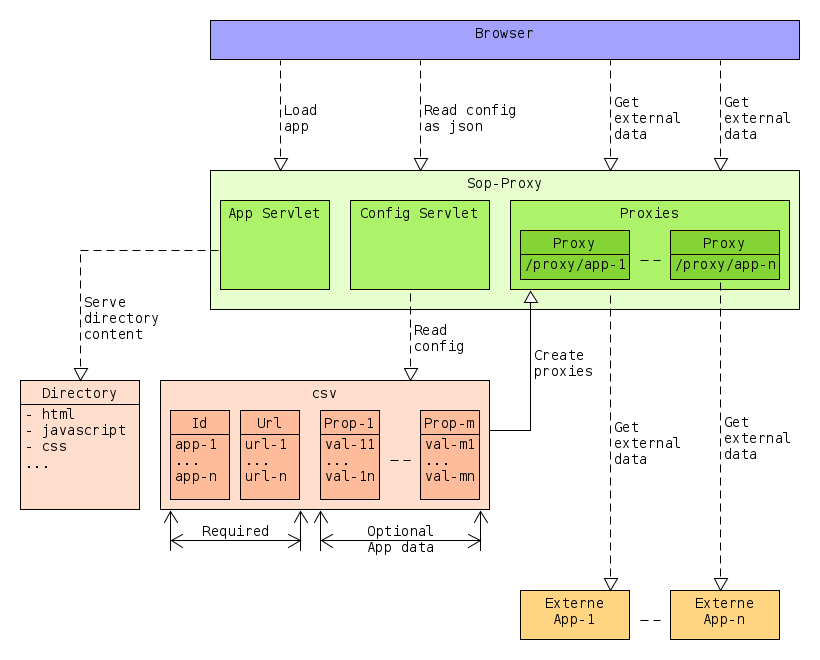The Sop-Proxy is a program that allows a javascript application to access data on different servers. It is an easy to use proxy that addresses the restrictions of the same-origin-policy.
The application is started with a csv file, which contains definitions of the remote targets, that should be reached. Each target has at least an id and an url and for each target a proxy servlet is created with the id as part of the context path.
Additionally the Sop-Proxy has a servlet the serves the content of a configured directory. The directory contains the javascript application (html, css, javascript, ...).
The last part of the Sop-Proxy is a config servlet, which provides a simple REST api for the configured proxies.
The following example illustrates the usage of the sop-proxy. The files can be found in the resources directory
The proxy is provided as an executable jar file that can be downloaded here. It is called with a properties file.
java -jar sop-proxy-exec-0.1.jar <properties-file>You can get a template of the properties file by calling:
java -jar sop-proxy-exec-0.1.jar template > sop-pproxy.propsAt least the following parameters have to be set in the properties file.
csv.file=<csv-file>
app.path=<app-directory with: html, javascript, css, ...>
We have to create a csv file with the proxy configurations. It contains the required id and url for each proxy and additionally a name to display in the javascript application. The following diagram shows the csv file, the request from the browser and the request that is send to the target by the proxy.
In our current example we are trying to access the target with https. To validate the remote certificate we need to create and configure a trust store. Download the certificate and import it to a trust store with the following command:
keytool -import -file google-books.pem -alias google-books -keystore trust-store -storepass changeit
With the preparations done, you can write an application, that lists, for
example informations about a book, that was requested from google with the uri:
/proxy/books/volumes?q=isbn:1492037257.
<script src="https://ajax.googleapis.com/ajax/libs/jquery/3.4.1/jquery.min.js"></script>
<script>
$(document).ready(function() {
$.get("/proxy/books/volumes?q=isbn:1492037257", function(data, status){
var book = $('#book');
book.append('<tr><td>ISBN</td><td>1492037257</td></tr>');
book.append('<tr><td>Title</td><td>'+data.items[0].volumeInfo.title+'</td></tr>');
book.append('<tr><td>Subtitle</td><td>'+data.items[0].volumeInfo.subtitle+'</td></tr>');
});
});
</script>
...
<h2>Book</h2>
<table id="book">
<tr> <th>Name</th> <th>Value</th> </tr>
</table>You can get a list of all proxy configurations with the following command:
http://localhost:8080/config/list
[
{
"id": "books",
"url": "https://www.googleapis.com/books/v1/",
"data": {
"name": "Books"
}
},
{
"id": "weather",
"url": "https://www.weatherapi.com/docs/",
"data": {
"name": "Weather"
}
}
]It is also possible to access an individual proxy configuration with the id of the proxy:
http://localhost:8080/config/get/books
{
"id": "books",
"url": "https://www.googleapis.com/books/v1/",
"data": {
"name": "Books"
}
}
